| Botanical Name |
|
| Family |
Pittosporaceae - The cheesewood family. |
| Pronunciation |
pit-0h-SPOR-um vir-id-uh-FLOR-um |
| Common Name(s) |
English: Cheesewood; White Cape Beech
Afrikaans: Kasuur; Witboekenhout
IsiZulu: umVusamvu; Umkhwenkwe
Sesotho sa Leboa: Kgalagangwe
Setswana: Mpustinya-poqo; Nkasur
Tshivenda: Mutanzwakhamelo ; Mulondwane
|
| Plant Group |
- Tree A woody, self-supporting perennial plant usually with a single main stem and generally growing more than 6 meters tall.
|
| Plant Size |
- Very large
| Tree | Over 25m |
| Shrub | Over 4m |
| Perennial/ground cover | Over 1m |
| Bulb | Over 1.2m |
| Succulent | 1.5m to 2m |
- Small
| Tree | 4m to 8m |
| Shrub | 50cm to 75cm |
| Perennial/ground cover | 10cm to 20cm |
| Bulb | 20cm to 30cm |
| Succulent | 10cm to 20cm |
|
| Position |
- Light or Dappled Shade Found below trees with sparse, open foliage. Ideal for the protection of herbaceous plants.
- Partial Shade The area is in shade for part of the day and in full sun for part of the day.
- Sun The area is in full sun for all or most of the day, all year round.
|
| General Information |
- Attractive fruits, berries or seeds Brightly coloured fruits or berries increase and extend the visual impact of the plant and are especially attractive to birds and other small wildlife.
- Drought Tolerance: High The plant is well adapted to arid conditions; it can survive long periods of drought and high temperatures without extra water.
- Evergreen Plants that have leaves all year round.
- Fragrant / Aromatic These plants posses a strong, usually pleasant odour.
- Frost: Half-hardy The plant is able to survive low temperatures and some frost but requires protection against severe frost.
- Roots Non-invasive Safe to plant near pools, paving, walls or buildings.
- Water Wise Plant species originating from low rainfall regions that require less water to survive and thrive than other plant species.
- Wind Tolerant Plants able to withstand the effect of strong winds.
|
| Specific Information |
An attractive shade tree with a rounded crown. Pittosporum vividiflorum can grow to a height of 30m in a forest but seldom reaches more that 4-6m in a garden situation. This plant is very showy when the seed capsules split open to reveal numerous small, shiny, orange-red, sticky seeds. The Cheesewood is often confused with the white milkwood (Sideroxlon inerme). To tell them apart, break a small twig off the tree. If you see a milky sap, it's a milkwood. The twigs of the Cheesewood snap easily and are markedly dry.
|
| Ad Break |
|
| Flowers |
| Description |
star-shaped flowers in tight, round clusters
|
| Season |
- Spring to Summer Plants will seldom bloom for the entire season as given in the list, but should flower during a period within these parameters.
|
| Colour |
|
| Growth Rate |
- Fast Specifying growth rate can be very misleading as there is considerable variation of growth rate depending on type and species of plant, available water, supplementary feeding, mulching and general care, as well as the plants suitability and adaptability to the garden environment.
|
| Plant Uses |
- Attracts bees, butterflies or other insects This plant attracts insects which can be food for birds or other creatures in your garden.
- Attracts Birds This plant will attract birds.
- Boundary A plant useful for planting around the edges of the property to form a green or colourful backdrop, an impenetrable hedge, to hide walls or create privacy.
- Container Trees, shrubs and ornamental species that can adapt to growing in a restricted environment.
- Hedge Suitable trees or shrubs planted relatively close together so that the branches intertwine to create a barrier. This can be formal – the plants are regularly trimmed to produce a neat shape, or informal – the plants are left to themselves to create a natural hedgerow.
- Pioneer for new gardens A very fast growing plant, able to withstand hardship, that can be used to populate land that has recently been cleared of natural vegetation. These plants pave the way for slower-growing species by adding nutrients to the soil and creating leaf litter.
- Provides deep shade A dense evergreen tree useful for a low light planting environment or for a recreational shade area.
- Screen A tall hedge of suitable plants planted closely together and used as a windbreak, to block a bad view, to separate parts of the garden or as a backdrop.
- Suitable for coastal gardens Plants adapted to dry, sandy soil, forceful wind, limited rainfall and intense sunlight.
- Suitable for smaller gardens Such plants do not have invasive root systems, remain small or controllable and can often be grown in containers.
- Wild Garden An indigenous garden planted for the benefit of wildlife and birds. Provides food, water, a variety of mini-biomes and no poisonous chemicals are used.
- Windbreak Trees planted in a row to form protection from prevailing winds by breaking the force of the wind, thereby reducing wind damage.
|
| Distribution and Habitat |
eastern half of South Africa, from the Western Cape to tropical Africa, Arabia and India, in tall forests, in scrub on forest margins, in kloofs and on the banks of streams
|
| Planting Suggestions |
Pittosporum Viridiflorum is one of the perfect garden trees: non-invasive roots, a good shape, scented flowers, attractive seeds, shiny evergreen foliage and it does not make a mess.re, bone-meal and your choice of fertiliser. Mulch well and water regularly during the first year or two for optimum growth.
The old method of digging a deep hole and filling it with soil and compost has resulted in many trees failing to thrive, dying, rotting at the base or worse still, falling over in later years due to poor root development. Refer to the following sites for the best method of planting trees:
Treehelp.com: Planting a tree
International Society of Arboriculture: New Tree Planting
Tree People: Plant the right way
For those of you who have a clay problem try:
Rod's Garden: Planting in clay soil
|
| Medicinal Uses |
Decoctions and infusions of the bitter stem bark are used medicinally to treat stomach complaints, abdominal pain, fever, to ease pain and to calm the patient. Dried, powdered root or bark is reportedly added to beer as an aphrodisiac. The bark has a strong resinous or liquorice smell.
|
| Ad Break |
|


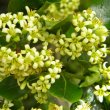

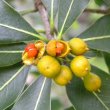
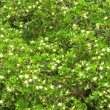
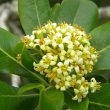
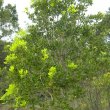
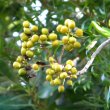


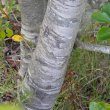


Comments
The stickyness of the seeds
I'm busy doing abit of research on the germination of this seed and find the stickyness quite a problem. What method would you suggest and is there a way to get rid of the stickyness?
Kind regards
Francois
Sticky seeds
Hi Francois
I also found the seeds difficult to work with. I washed them in warm water, giving them a vigorous rub between the palms of my hands, then dried them out on mesh under light shade. This helped quite a bit and the seeds germinated well with this treatment.
The seeds germinated successfully in well drained garden soil. In fact they also come up all over my property on their own.
Hope this helps.
Kind regards
Lorraine
Cheesewood germination
Hi, I just want to find out, how long it takes for a Cheesewood tree to bear fruit, then thereafter, how long it takes for the seed to germinate? I have a 50 metre boundary wall that I would like to screen, and do not have the money to buy as many trees. The idea is to buy a few then harvest the seeds to grow the rest of the trees, but I do not want to wait for 5 years to do this. Also, Lorraine mentions, "In fact they also come up all over my property" ... is this a common problem with this tree? I do not want the trees growing where I have not intended for them to grow... how difficult/easy is it to control this?
Germination of Cheesewood seed
Hi Terrence
The young trees in my garden take quite a few years before they flower and seed. You won't need more than twenty-five trees for a pretty dense screen. I would buy seeds and grow all the trees needed. You can buy seeds from silverhillseeds.co.za (present cost R22 for 100 seeds).
Certain birds love the seeds so they drop them all over the place. My 6 acre plot is mostly wild veld and I find it too large to eradicate all the seedlings. I don't know if this is a common problem but I assume it might be. The only way to control them would be to keep a constant patrol of your property and pull the seedlings out as they appear.
However, Pittosporum viridiflorum is a protected tree in South Africa: http://www.sanbi.org/sites/default/files/documents/documents/saprotected...
I am not sure how or whether this law is applied to private property. Contact the Nature Conservation office in your province for clarity on this.
Kind regards
Lorraine
Cheesewood in the Western Cape
Hi Lorraine
Just thought I would 'chip in' on the Cheeswood subject. I planted one last summer 2013/2014 and it's doing remarkably well here in Stilbaai. It's in the back garden, fairly protected by the outbuilding on one side and the neighbours Myoporums on the adjacent side. It gets hit when the West wind blows since it is a bit exposed on that side and branches break off. This is probably because its a soft wood tree and still young to boot. Bob
Pittosporum viridiflorum in the Western Cape
Hi Bob
Thanks for your input - much appreciated.
Kind regards
Lorraine
Discuss this plant
Share knowledge, ask a question or give an experience.